International Supply Chain Management: China to Sri Lanka Challenges
VerifiedAdded on 2023/01/18
|13
|3164
|42
Report
AI Summary
This report analyzes the international supply chain management of perishable goods, specifically focusing on the transportation of fruits from China to Sri Lanka. The study begins by examining the trade policies of both countries and highlighting the challenges associated with cargo shipment, such as cargo damage, packaging issues, and temperature control. It explores the best methods for transporting perishable goods, advocating for air freight due to its speed and reduced risk of spoilage. The report also discusses the challenges of tracking, packaging, and maintaining quality during transit, as well as potential penalties and custom clearance problems. Furthermore, the report suggests solutions to overcome these challenges, including the use of the Internet of Things, automation of inventory and task management, big data analytics, and the maintenance of transparency through IT systems, and automation of the logistics system. The study concludes by emphasizing the importance of efficient supply chain management in ensuring timely delivery and minimizing losses.
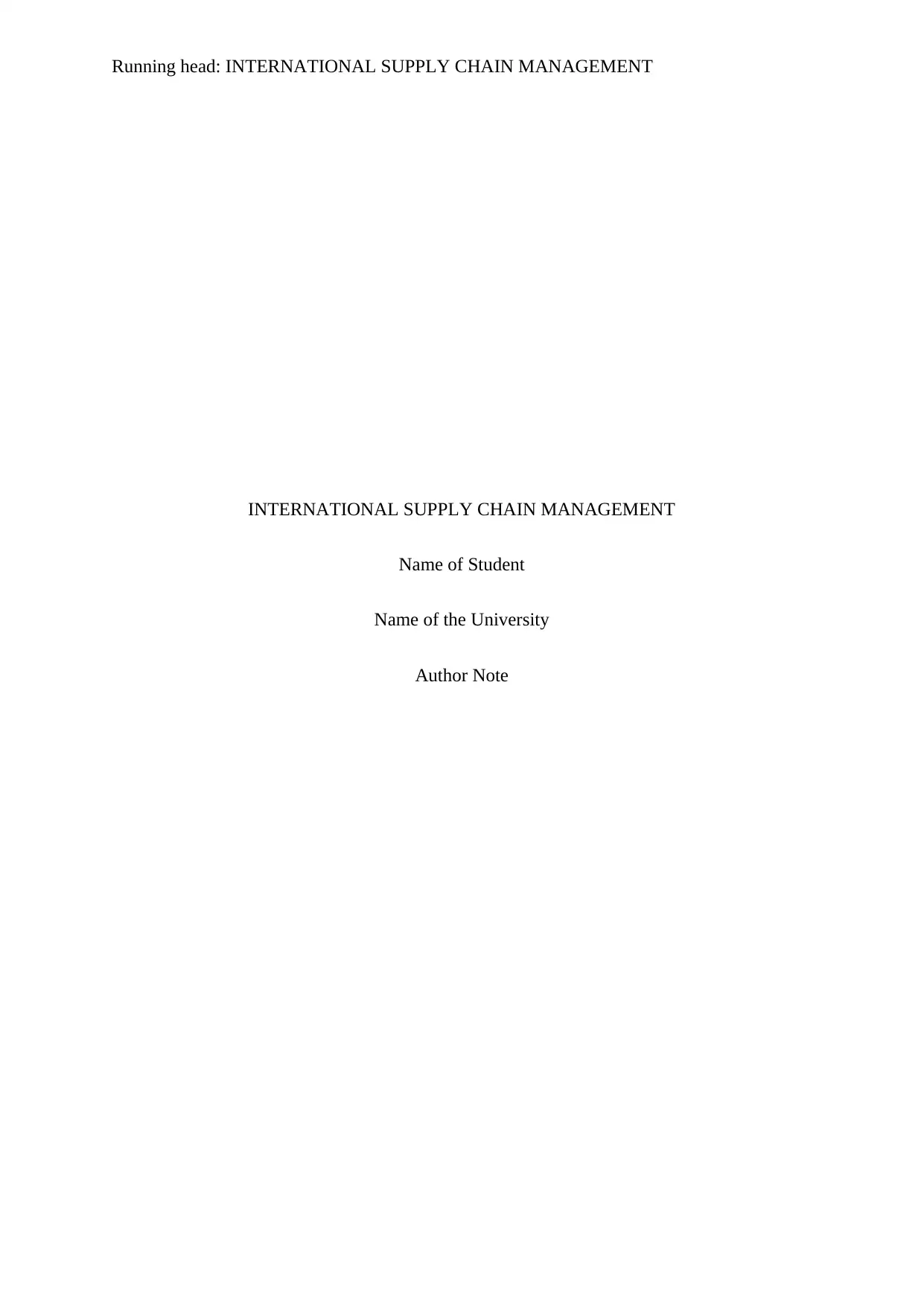
Running head: INTERNATIONAL SUPPLY CHAIN MANAGEMENT
INTERNATIONAL SUPPLY CHAIN MANAGEMENT
Name of Student
Name of the University
Author Note
INTERNATIONAL SUPPLY CHAIN MANAGEMENT
Name of Student
Name of the University
Author Note
Paraphrase This Document
Need a fresh take? Get an instant paraphrase of this document with our AI Paraphraser
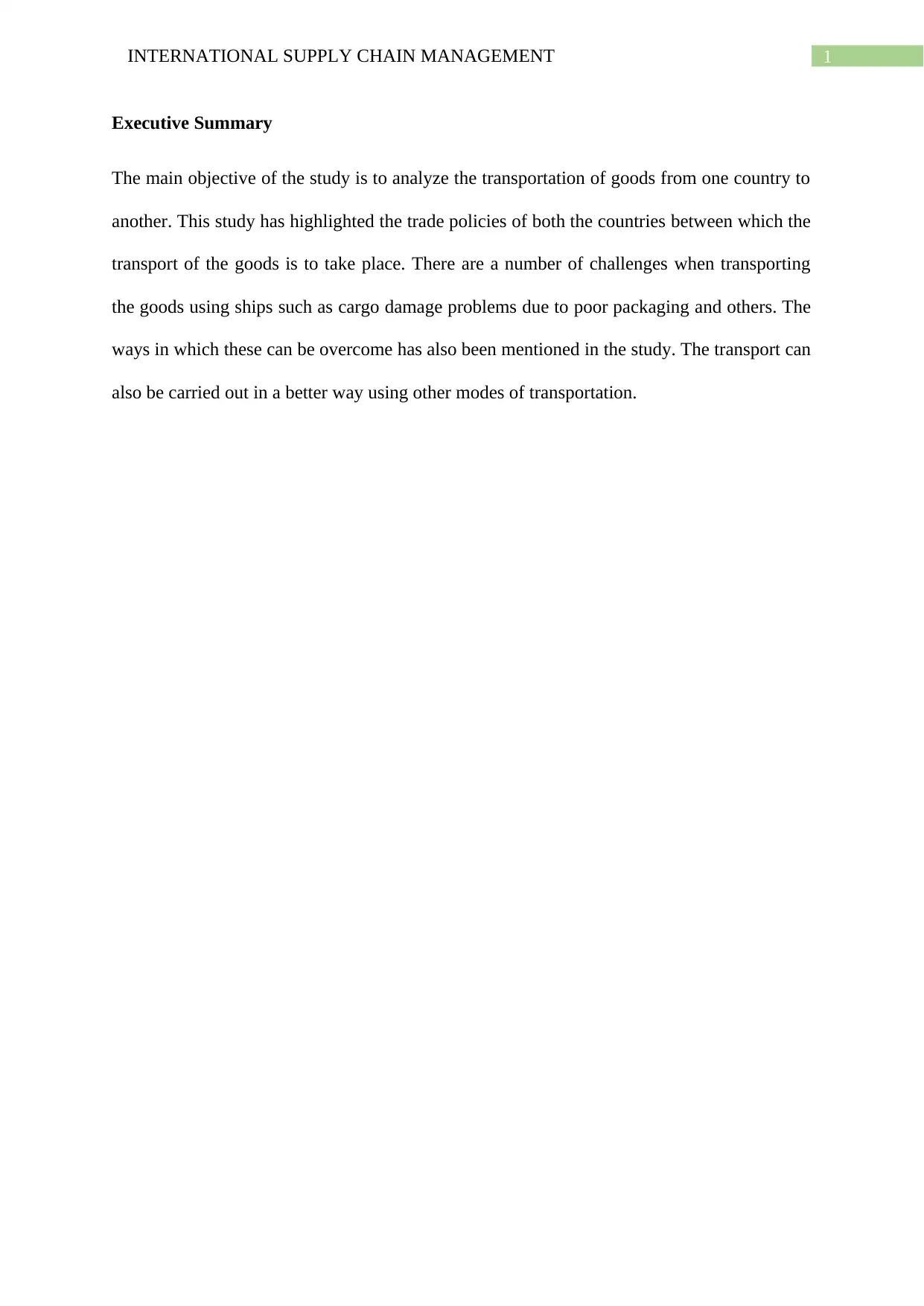
1INTERNATIONAL SUPPLY CHAIN MANAGEMENT
Executive Summary
The main objective of the study is to analyze the transportation of goods from one country to
another. This study has highlighted the trade policies of both the countries between which the
transport of the goods is to take place. There are a number of challenges when transporting
the goods using ships such as cargo damage problems due to poor packaging and others. The
ways in which these can be overcome has also been mentioned in the study. The transport can
also be carried out in a better way using other modes of transportation.
Executive Summary
The main objective of the study is to analyze the transportation of goods from one country to
another. This study has highlighted the trade policies of both the countries between which the
transport of the goods is to take place. There are a number of challenges when transporting
the goods using ships such as cargo damage problems due to poor packaging and others. The
ways in which these can be overcome has also been mentioned in the study. The transport can
also be carried out in a better way using other modes of transportation.
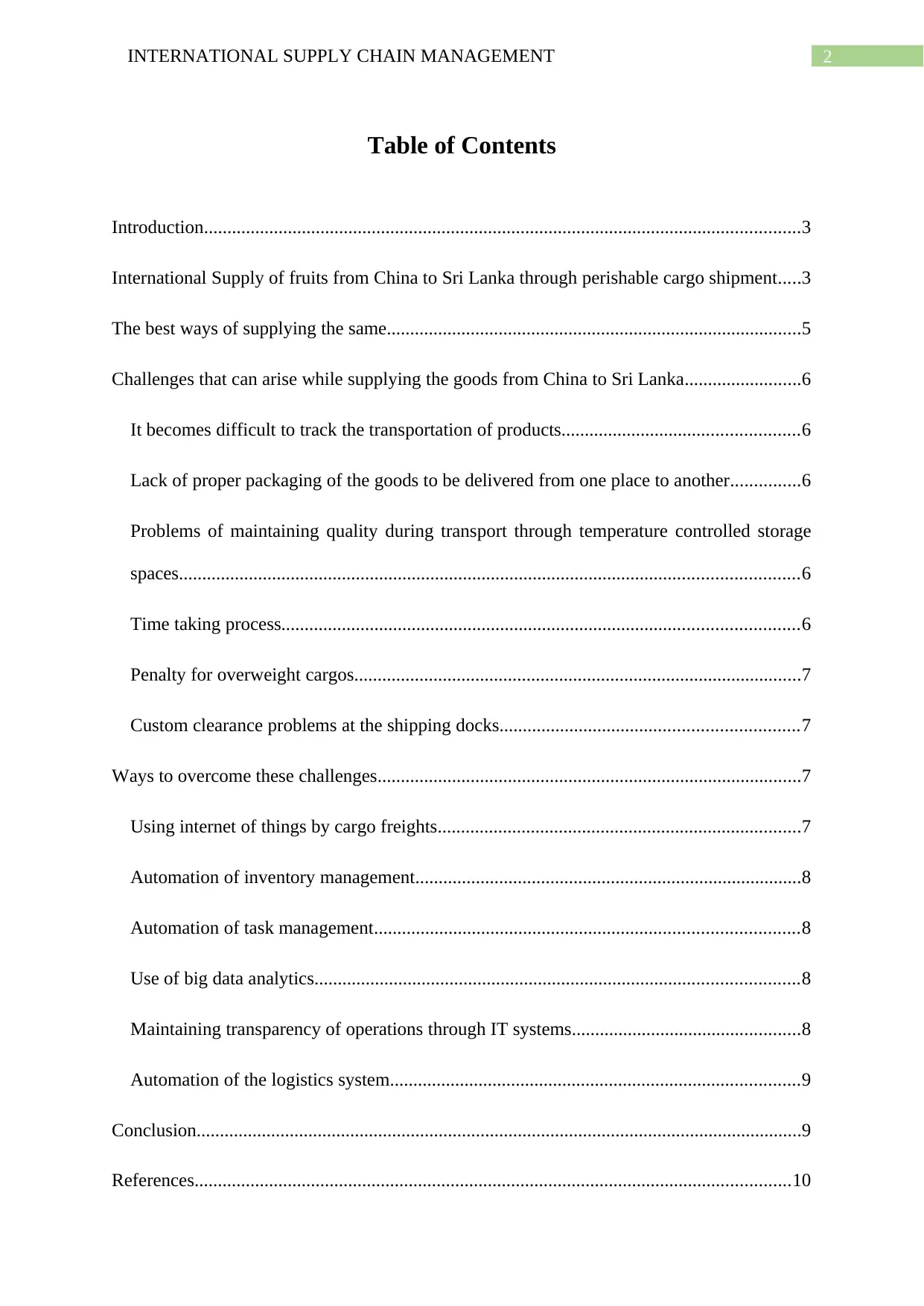
2INTERNATIONAL SUPPLY CHAIN MANAGEMENT
Table of Contents
Introduction................................................................................................................................3
International Supply of fruits from China to Sri Lanka through perishable cargo shipment.....3
The best ways of supplying the same.........................................................................................5
Challenges that can arise while supplying the goods from China to Sri Lanka.........................6
It becomes difficult to track the transportation of products...................................................6
Lack of proper packaging of the goods to be delivered from one place to another...............6
Problems of maintaining quality during transport through temperature controlled storage
spaces.....................................................................................................................................6
Time taking process...............................................................................................................6
Penalty for overweight cargos................................................................................................7
Custom clearance problems at the shipping docks................................................................7
Ways to overcome these challenges...........................................................................................7
Using internet of things by cargo freights..............................................................................7
Automation of inventory management...................................................................................8
Automation of task management...........................................................................................8
Use of big data analytics........................................................................................................8
Maintaining transparency of operations through IT systems.................................................8
Automation of the logistics system........................................................................................9
Conclusion..................................................................................................................................9
References................................................................................................................................10
Table of Contents
Introduction................................................................................................................................3
International Supply of fruits from China to Sri Lanka through perishable cargo shipment.....3
The best ways of supplying the same.........................................................................................5
Challenges that can arise while supplying the goods from China to Sri Lanka.........................6
It becomes difficult to track the transportation of products...................................................6
Lack of proper packaging of the goods to be delivered from one place to another...............6
Problems of maintaining quality during transport through temperature controlled storage
spaces.....................................................................................................................................6
Time taking process...............................................................................................................6
Penalty for overweight cargos................................................................................................7
Custom clearance problems at the shipping docks................................................................7
Ways to overcome these challenges...........................................................................................7
Using internet of things by cargo freights..............................................................................7
Automation of inventory management...................................................................................8
Automation of task management...........................................................................................8
Use of big data analytics........................................................................................................8
Maintaining transparency of operations through IT systems.................................................8
Automation of the logistics system........................................................................................9
Conclusion..................................................................................................................................9
References................................................................................................................................10
⊘ This is a preview!⊘
Do you want full access?
Subscribe today to unlock all pages.

Trusted by 1+ million students worldwide
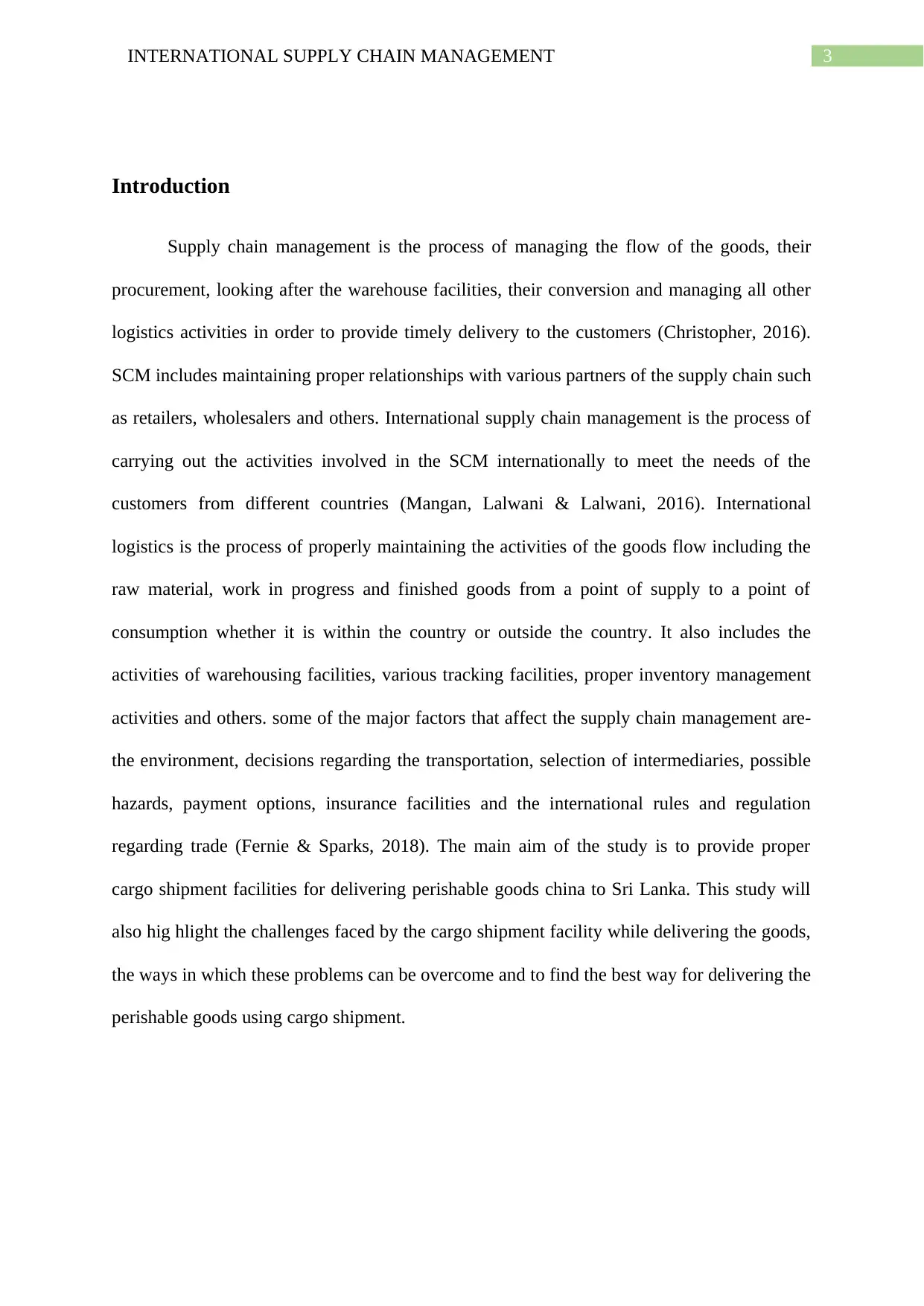
3INTERNATIONAL SUPPLY CHAIN MANAGEMENT
Introduction
Supply chain management is the process of managing the flow of the goods, their
procurement, looking after the warehouse facilities, their conversion and managing all other
logistics activities in order to provide timely delivery to the customers (Christopher, 2016).
SCM includes maintaining proper relationships with various partners of the supply chain such
as retailers, wholesalers and others. International supply chain management is the process of
carrying out the activities involved in the SCM internationally to meet the needs of the
customers from different countries (Mangan, Lalwani & Lalwani, 2016). International
logistics is the process of properly maintaining the activities of the goods flow including the
raw material, work in progress and finished goods from a point of supply to a point of
consumption whether it is within the country or outside the country. It also includes the
activities of warehousing facilities, various tracking facilities, proper inventory management
activities and others. some of the major factors that affect the supply chain management are-
the environment, decisions regarding the transportation, selection of intermediaries, possible
hazards, payment options, insurance facilities and the international rules and regulation
regarding trade (Fernie & Sparks, 2018). The main aim of the study is to provide proper
cargo shipment facilities for delivering perishable goods china to Sri Lanka. This study will
also hig hlight the challenges faced by the cargo shipment facility while delivering the goods,
the ways in which these problems can be overcome and to find the best way for delivering the
perishable goods using cargo shipment.
Introduction
Supply chain management is the process of managing the flow of the goods, their
procurement, looking after the warehouse facilities, their conversion and managing all other
logistics activities in order to provide timely delivery to the customers (Christopher, 2016).
SCM includes maintaining proper relationships with various partners of the supply chain such
as retailers, wholesalers and others. International supply chain management is the process of
carrying out the activities involved in the SCM internationally to meet the needs of the
customers from different countries (Mangan, Lalwani & Lalwani, 2016). International
logistics is the process of properly maintaining the activities of the goods flow including the
raw material, work in progress and finished goods from a point of supply to a point of
consumption whether it is within the country or outside the country. It also includes the
activities of warehousing facilities, various tracking facilities, proper inventory management
activities and others. some of the major factors that affect the supply chain management are-
the environment, decisions regarding the transportation, selection of intermediaries, possible
hazards, payment options, insurance facilities and the international rules and regulation
regarding trade (Fernie & Sparks, 2018). The main aim of the study is to provide proper
cargo shipment facilities for delivering perishable goods china to Sri Lanka. This study will
also hig hlight the challenges faced by the cargo shipment facility while delivering the goods,
the ways in which these problems can be overcome and to find the best way for delivering the
perishable goods using cargo shipment.
Paraphrase This Document
Need a fresh take? Get an instant paraphrase of this document with our AI Paraphraser
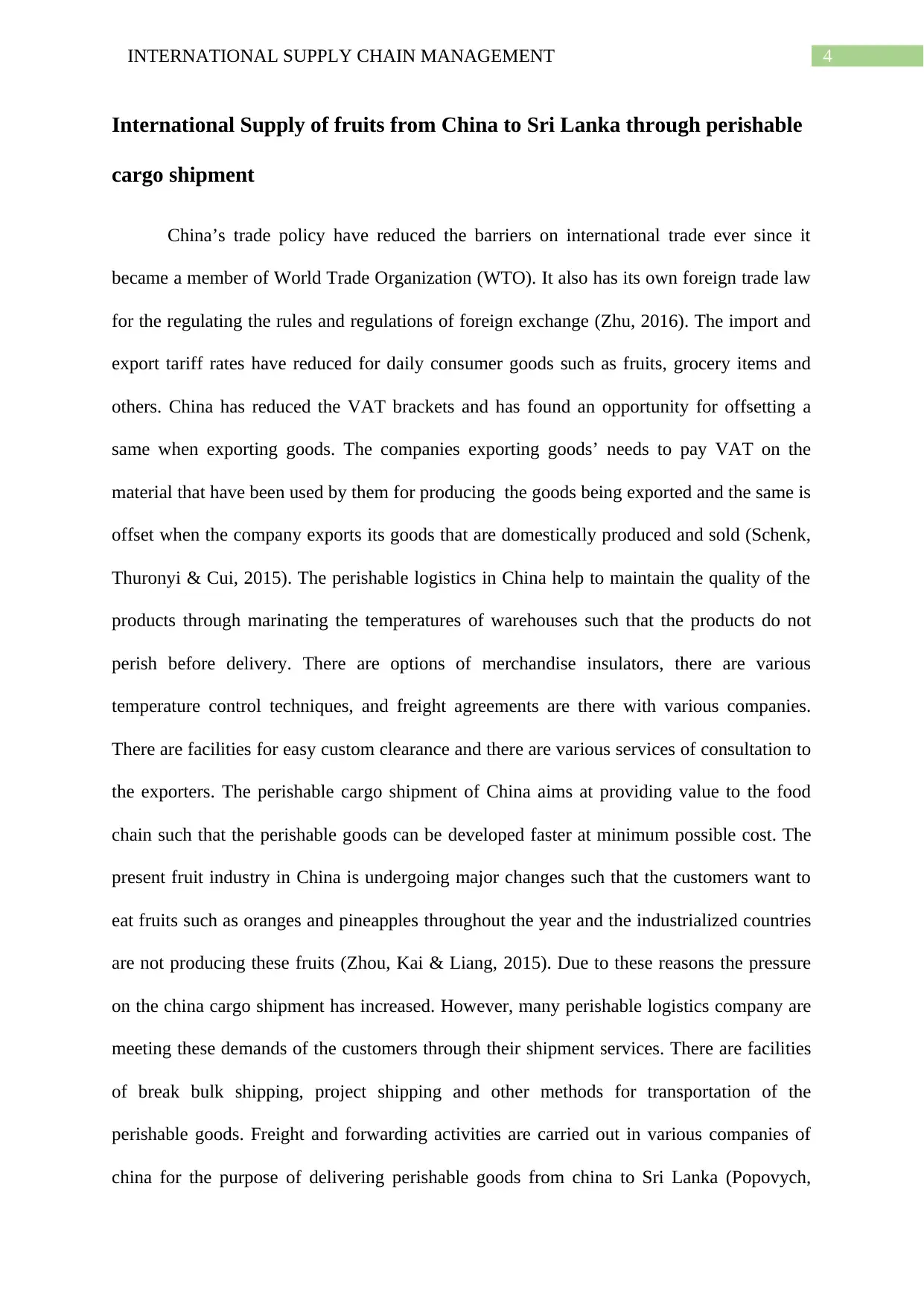
4INTERNATIONAL SUPPLY CHAIN MANAGEMENT
International Supply of fruits from China to Sri Lanka through perishable
cargo shipment
China’s trade policy have reduced the barriers on international trade ever since it
became a member of World Trade Organization (WTO). It also has its own foreign trade law
for the regulating the rules and regulations of foreign exchange (Zhu, 2016). The import and
export tariff rates have reduced for daily consumer goods such as fruits, grocery items and
others. China has reduced the VAT brackets and has found an opportunity for offsetting a
same when exporting goods. The companies exporting goods’ needs to pay VAT on the
material that have been used by them for producing the goods being exported and the same is
offset when the company exports its goods that are domestically produced and sold (Schenk,
Thuronyi & Cui, 2015). The perishable logistics in China help to maintain the quality of the
products through marinating the temperatures of warehouses such that the products do not
perish before delivery. There are options of merchandise insulators, there are various
temperature control techniques, and freight agreements are there with various companies.
There are facilities for easy custom clearance and there are various services of consultation to
the exporters. The perishable cargo shipment of China aims at providing value to the food
chain such that the perishable goods can be developed faster at minimum possible cost. The
present fruit industry in China is undergoing major changes such that the customers want to
eat fruits such as oranges and pineapples throughout the year and the industrialized countries
are not producing these fruits (Zhou, Kai & Liang, 2015). Due to these reasons the pressure
on the china cargo shipment has increased. However, many perishable logistics company are
meeting these demands of the customers through their shipment services. There are facilities
of break bulk shipping, project shipping and other methods for transportation of the
perishable goods. Freight and forwarding activities are carried out in various companies of
china for the purpose of delivering perishable goods from china to Sri Lanka (Popovych,
International Supply of fruits from China to Sri Lanka through perishable
cargo shipment
China’s trade policy have reduced the barriers on international trade ever since it
became a member of World Trade Organization (WTO). It also has its own foreign trade law
for the regulating the rules and regulations of foreign exchange (Zhu, 2016). The import and
export tariff rates have reduced for daily consumer goods such as fruits, grocery items and
others. China has reduced the VAT brackets and has found an opportunity for offsetting a
same when exporting goods. The companies exporting goods’ needs to pay VAT on the
material that have been used by them for producing the goods being exported and the same is
offset when the company exports its goods that are domestically produced and sold (Schenk,
Thuronyi & Cui, 2015). The perishable logistics in China help to maintain the quality of the
products through marinating the temperatures of warehouses such that the products do not
perish before delivery. There are options of merchandise insulators, there are various
temperature control techniques, and freight agreements are there with various companies.
There are facilities for easy custom clearance and there are various services of consultation to
the exporters. The perishable cargo shipment of China aims at providing value to the food
chain such that the perishable goods can be developed faster at minimum possible cost. The
present fruit industry in China is undergoing major changes such that the customers want to
eat fruits such as oranges and pineapples throughout the year and the industrialized countries
are not producing these fruits (Zhou, Kai & Liang, 2015). Due to these reasons the pressure
on the china cargo shipment has increased. However, many perishable logistics company are
meeting these demands of the customers through their shipment services. There are facilities
of break bulk shipping, project shipping and other methods for transportation of the
perishable goods. Freight and forwarding activities are carried out in various companies of
china for the purpose of delivering perishable goods from china to Sri Lanka (Popovych,
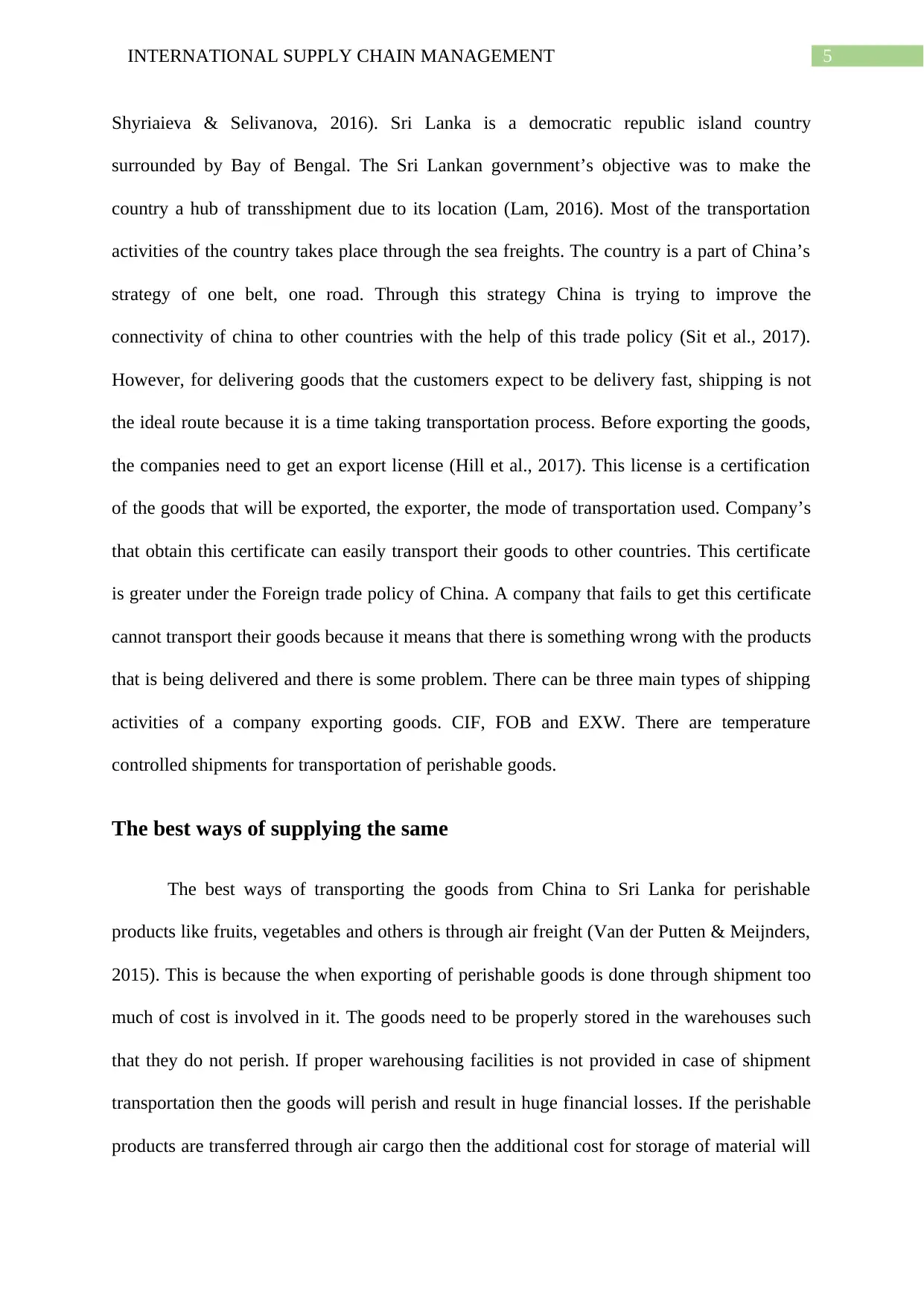
5INTERNATIONAL SUPPLY CHAIN MANAGEMENT
Shyriaieva & Selivanova, 2016). Sri Lanka is a democratic republic island country
surrounded by Bay of Bengal. The Sri Lankan government’s objective was to make the
country a hub of transshipment due to its location (Lam, 2016). Most of the transportation
activities of the country takes place through the sea freights. The country is a part of China’s
strategy of one belt, one road. Through this strategy China is trying to improve the
connectivity of china to other countries with the help of this trade policy (Sit et al., 2017).
However, for delivering goods that the customers expect to be delivery fast, shipping is not
the ideal route because it is a time taking transportation process. Before exporting the goods,
the companies need to get an export license (Hill et al., 2017). This license is a certification
of the goods that will be exported, the exporter, the mode of transportation used. Company’s
that obtain this certificate can easily transport their goods to other countries. This certificate
is greater under the Foreign trade policy of China. A company that fails to get this certificate
cannot transport their goods because it means that there is something wrong with the products
that is being delivered and there is some problem. There can be three main types of shipping
activities of a company exporting goods. CIF, FOB and EXW. There are temperature
controlled shipments for transportation of perishable goods.
The best ways of supplying the same
The best ways of transporting the goods from China to Sri Lanka for perishable
products like fruits, vegetables and others is through air freight (Van der Putten & Meijnders,
2015). This is because the when exporting of perishable goods is done through shipment too
much of cost is involved in it. The goods need to be properly stored in the warehouses such
that they do not perish. If proper warehousing facilities is not provided in case of shipment
transportation then the goods will perish and result in huge financial losses. If the perishable
products are transferred through air cargo then the additional cost for storage of material will
Shyriaieva & Selivanova, 2016). Sri Lanka is a democratic republic island country
surrounded by Bay of Bengal. The Sri Lankan government’s objective was to make the
country a hub of transshipment due to its location (Lam, 2016). Most of the transportation
activities of the country takes place through the sea freights. The country is a part of China’s
strategy of one belt, one road. Through this strategy China is trying to improve the
connectivity of china to other countries with the help of this trade policy (Sit et al., 2017).
However, for delivering goods that the customers expect to be delivery fast, shipping is not
the ideal route because it is a time taking transportation process. Before exporting the goods,
the companies need to get an export license (Hill et al., 2017). This license is a certification
of the goods that will be exported, the exporter, the mode of transportation used. Company’s
that obtain this certificate can easily transport their goods to other countries. This certificate
is greater under the Foreign trade policy of China. A company that fails to get this certificate
cannot transport their goods because it means that there is something wrong with the products
that is being delivered and there is some problem. There can be three main types of shipping
activities of a company exporting goods. CIF, FOB and EXW. There are temperature
controlled shipments for transportation of perishable goods.
The best ways of supplying the same
The best ways of transporting the goods from China to Sri Lanka for perishable
products like fruits, vegetables and others is through air freight (Van der Putten & Meijnders,
2015). This is because the when exporting of perishable goods is done through shipment too
much of cost is involved in it. The goods need to be properly stored in the warehouses such
that they do not perish. If proper warehousing facilities is not provided in case of shipment
transportation then the goods will perish and result in huge financial losses. If the perishable
products are transferred through air cargo then the additional cost for storage of material will
⊘ This is a preview!⊘
Do you want full access?
Subscribe today to unlock all pages.

Trusted by 1+ million students worldwide
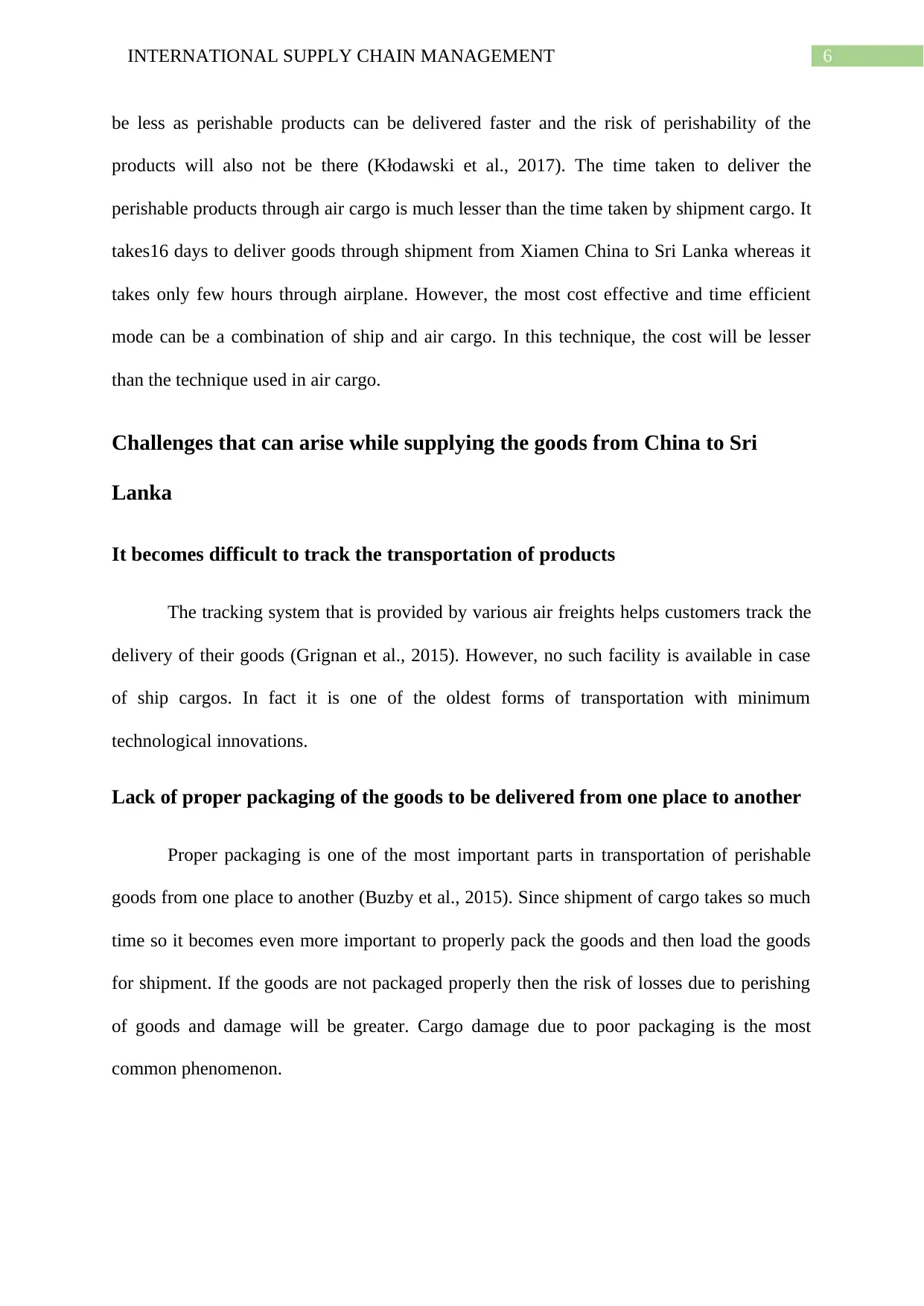
6INTERNATIONAL SUPPLY CHAIN MANAGEMENT
be less as perishable products can be delivered faster and the risk of perishability of the
products will also not be there (Kłodawski et al., 2017). The time taken to deliver the
perishable products through air cargo is much lesser than the time taken by shipment cargo. It
takes16 days to deliver goods through shipment from Xiamen China to Sri Lanka whereas it
takes only few hours through airplane. However, the most cost effective and time efficient
mode can be a combination of ship and air cargo. In this technique, the cost will be lesser
than the technique used in air cargo.
Challenges that can arise while supplying the goods from China to Sri
Lanka
It becomes difficult to track the transportation of products
The tracking system that is provided by various air freights helps customers track the
delivery of their goods (Grignan et al., 2015). However, no such facility is available in case
of ship cargos. In fact it is one of the oldest forms of transportation with minimum
technological innovations.
Lack of proper packaging of the goods to be delivered from one place to another
Proper packaging is one of the most important parts in transportation of perishable
goods from one place to another (Buzby et al., 2015). Since shipment of cargo takes so much
time so it becomes even more important to properly pack the goods and then load the goods
for shipment. If the goods are not packaged properly then the risk of losses due to perishing
of goods and damage will be greater. Cargo damage due to poor packaging is the most
common phenomenon.
be less as perishable products can be delivered faster and the risk of perishability of the
products will also not be there (Kłodawski et al., 2017). The time taken to deliver the
perishable products through air cargo is much lesser than the time taken by shipment cargo. It
takes16 days to deliver goods through shipment from Xiamen China to Sri Lanka whereas it
takes only few hours through airplane. However, the most cost effective and time efficient
mode can be a combination of ship and air cargo. In this technique, the cost will be lesser
than the technique used in air cargo.
Challenges that can arise while supplying the goods from China to Sri
Lanka
It becomes difficult to track the transportation of products
The tracking system that is provided by various air freights helps customers track the
delivery of their goods (Grignan et al., 2015). However, no such facility is available in case
of ship cargos. In fact it is one of the oldest forms of transportation with minimum
technological innovations.
Lack of proper packaging of the goods to be delivered from one place to another
Proper packaging is one of the most important parts in transportation of perishable
goods from one place to another (Buzby et al., 2015). Since shipment of cargo takes so much
time so it becomes even more important to properly pack the goods and then load the goods
for shipment. If the goods are not packaged properly then the risk of losses due to perishing
of goods and damage will be greater. Cargo damage due to poor packaging is the most
common phenomenon.
Paraphrase This Document
Need a fresh take? Get an instant paraphrase of this document with our AI Paraphraser
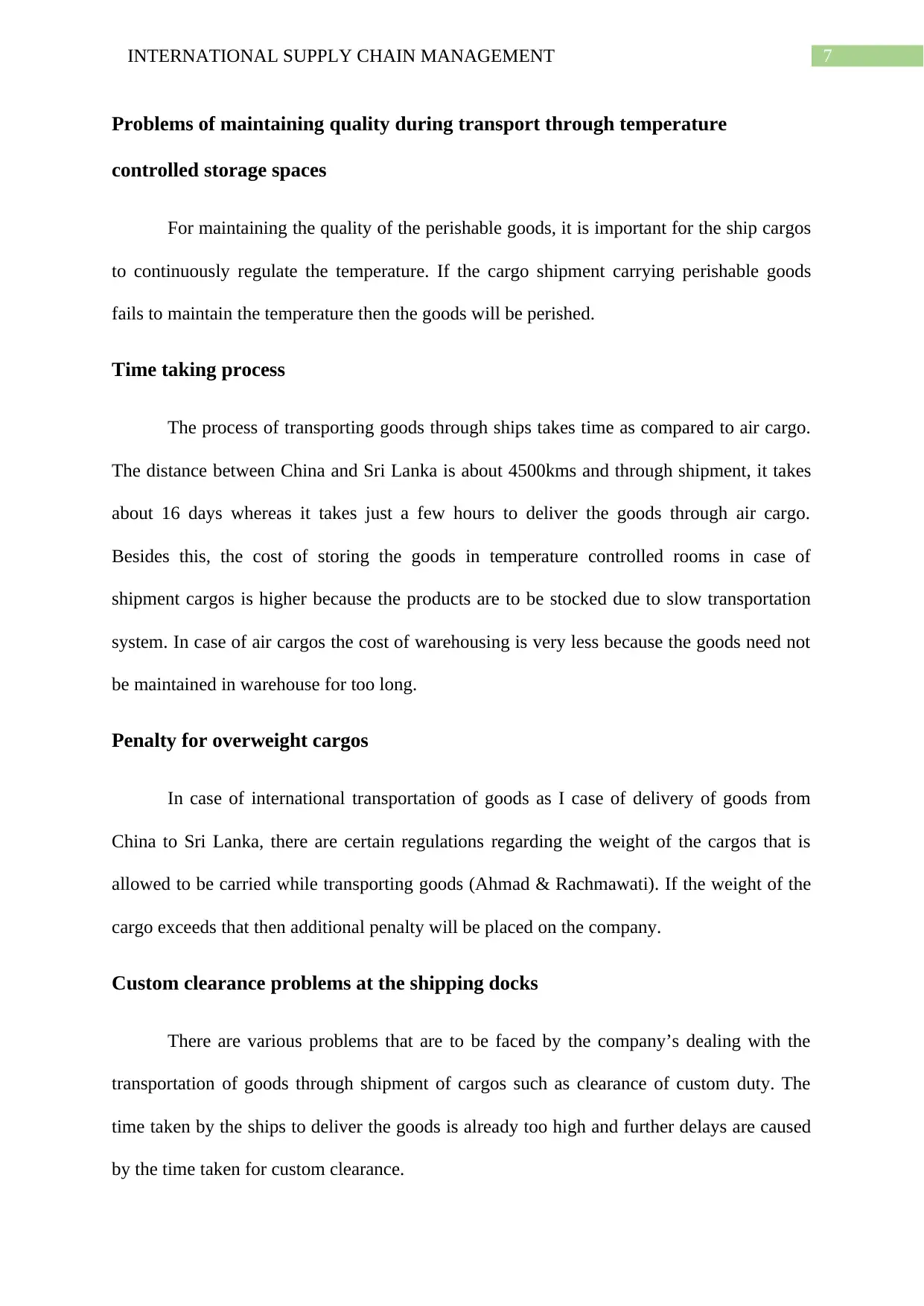
7INTERNATIONAL SUPPLY CHAIN MANAGEMENT
Problems of maintaining quality during transport through temperature
controlled storage spaces
For maintaining the quality of the perishable goods, it is important for the ship cargos
to continuously regulate the temperature. If the cargo shipment carrying perishable goods
fails to maintain the temperature then the goods will be perished.
Time taking process
The process of transporting goods through ships takes time as compared to air cargo.
The distance between China and Sri Lanka is about 4500kms and through shipment, it takes
about 16 days whereas it takes just a few hours to deliver the goods through air cargo.
Besides this, the cost of storing the goods in temperature controlled rooms in case of
shipment cargos is higher because the products are to be stocked due to slow transportation
system. In case of air cargos the cost of warehousing is very less because the goods need not
be maintained in warehouse for too long.
Penalty for overweight cargos
In case of international transportation of goods as I case of delivery of goods from
China to Sri Lanka, there are certain regulations regarding the weight of the cargos that is
allowed to be carried while transporting goods (Ahmad & Rachmawati). If the weight of the
cargo exceeds that then additional penalty will be placed on the company.
Custom clearance problems at the shipping docks
There are various problems that are to be faced by the company’s dealing with the
transportation of goods through shipment of cargos such as clearance of custom duty. The
time taken by the ships to deliver the goods is already too high and further delays are caused
by the time taken for custom clearance.
Problems of maintaining quality during transport through temperature
controlled storage spaces
For maintaining the quality of the perishable goods, it is important for the ship cargos
to continuously regulate the temperature. If the cargo shipment carrying perishable goods
fails to maintain the temperature then the goods will be perished.
Time taking process
The process of transporting goods through ships takes time as compared to air cargo.
The distance between China and Sri Lanka is about 4500kms and through shipment, it takes
about 16 days whereas it takes just a few hours to deliver the goods through air cargo.
Besides this, the cost of storing the goods in temperature controlled rooms in case of
shipment cargos is higher because the products are to be stocked due to slow transportation
system. In case of air cargos the cost of warehousing is very less because the goods need not
be maintained in warehouse for too long.
Penalty for overweight cargos
In case of international transportation of goods as I case of delivery of goods from
China to Sri Lanka, there are certain regulations regarding the weight of the cargos that is
allowed to be carried while transporting goods (Ahmad & Rachmawati). If the weight of the
cargo exceeds that then additional penalty will be placed on the company.
Custom clearance problems at the shipping docks
There are various problems that are to be faced by the company’s dealing with the
transportation of goods through shipment of cargos such as clearance of custom duty. The
time taken by the ships to deliver the goods is already too high and further delays are caused
by the time taken for custom clearance.
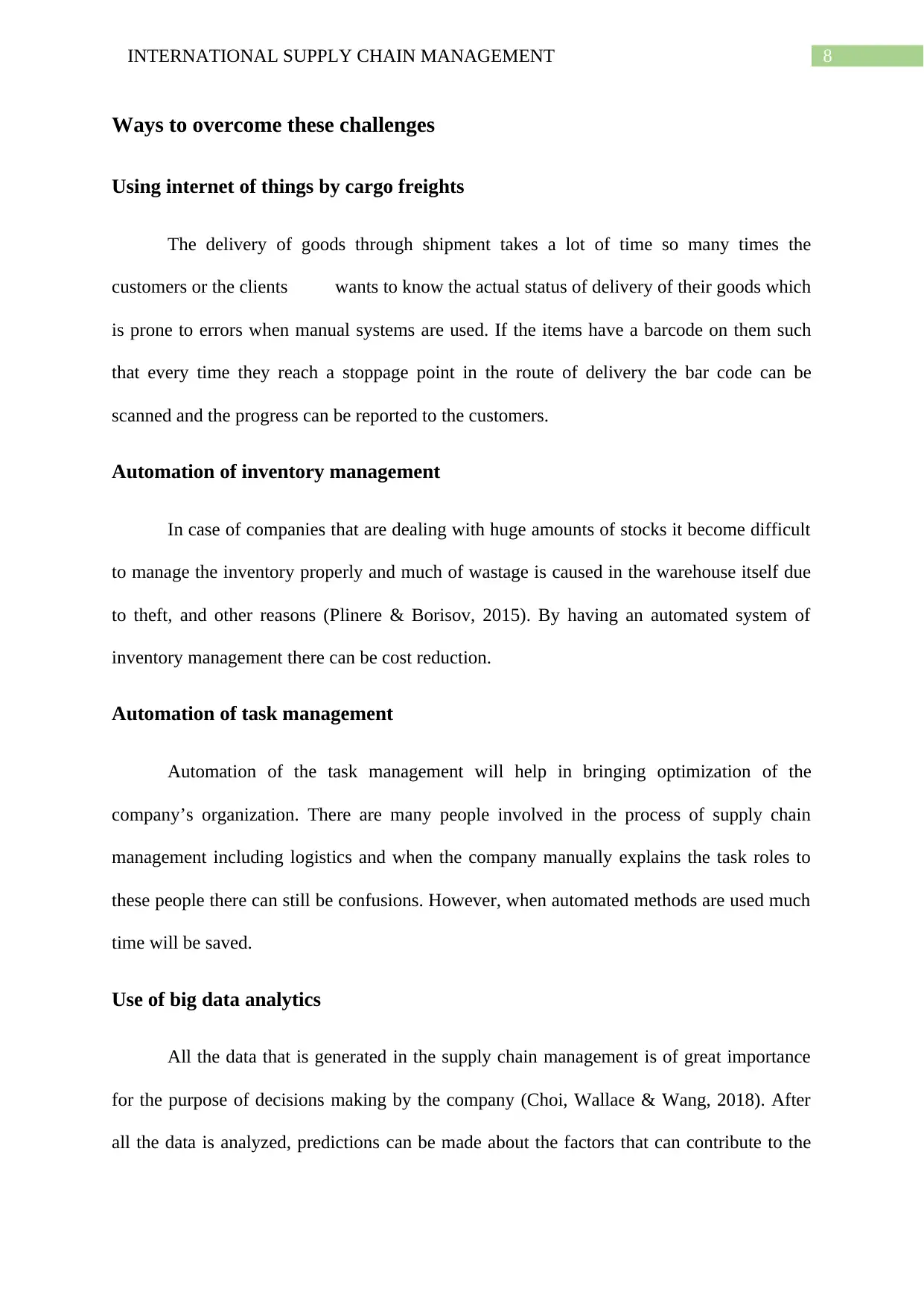
8INTERNATIONAL SUPPLY CHAIN MANAGEMENT
Ways to overcome these challenges
Using internet of things by cargo freights
The delivery of goods through shipment takes a lot of time so many times the
customers or the clients wants to know the actual status of delivery of their goods which
is prone to errors when manual systems are used. If the items have a barcode on them such
that every time they reach a stoppage point in the route of delivery the bar code can be
scanned and the progress can be reported to the customers.
Automation of inventory management
In case of companies that are dealing with huge amounts of stocks it become difficult
to manage the inventory properly and much of wastage is caused in the warehouse itself due
to theft, and other reasons (Plinere & Borisov, 2015). By having an automated system of
inventory management there can be cost reduction.
Automation of task management
Automation of the task management will help in bringing optimization of the
company’s organization. There are many people involved in the process of supply chain
management including logistics and when the company manually explains the task roles to
these people there can still be confusions. However, when automated methods are used much
time will be saved.
Use of big data analytics
All the data that is generated in the supply chain management is of great importance
for the purpose of decisions making by the company (Choi, Wallace & Wang, 2018). After
all the data is analyzed, predictions can be made about the factors that can contribute to the
Ways to overcome these challenges
Using internet of things by cargo freights
The delivery of goods through shipment takes a lot of time so many times the
customers or the clients wants to know the actual status of delivery of their goods which
is prone to errors when manual systems are used. If the items have a barcode on them such
that every time they reach a stoppage point in the route of delivery the bar code can be
scanned and the progress can be reported to the customers.
Automation of inventory management
In case of companies that are dealing with huge amounts of stocks it become difficult
to manage the inventory properly and much of wastage is caused in the warehouse itself due
to theft, and other reasons (Plinere & Borisov, 2015). By having an automated system of
inventory management there can be cost reduction.
Automation of task management
Automation of the task management will help in bringing optimization of the
company’s organization. There are many people involved in the process of supply chain
management including logistics and when the company manually explains the task roles to
these people there can still be confusions. However, when automated methods are used much
time will be saved.
Use of big data analytics
All the data that is generated in the supply chain management is of great importance
for the purpose of decisions making by the company (Choi, Wallace & Wang, 2018). After
all the data is analyzed, predictions can be made about the factors that can contribute to the
⊘ This is a preview!⊘
Do you want full access?
Subscribe today to unlock all pages.

Trusted by 1+ million students worldwide
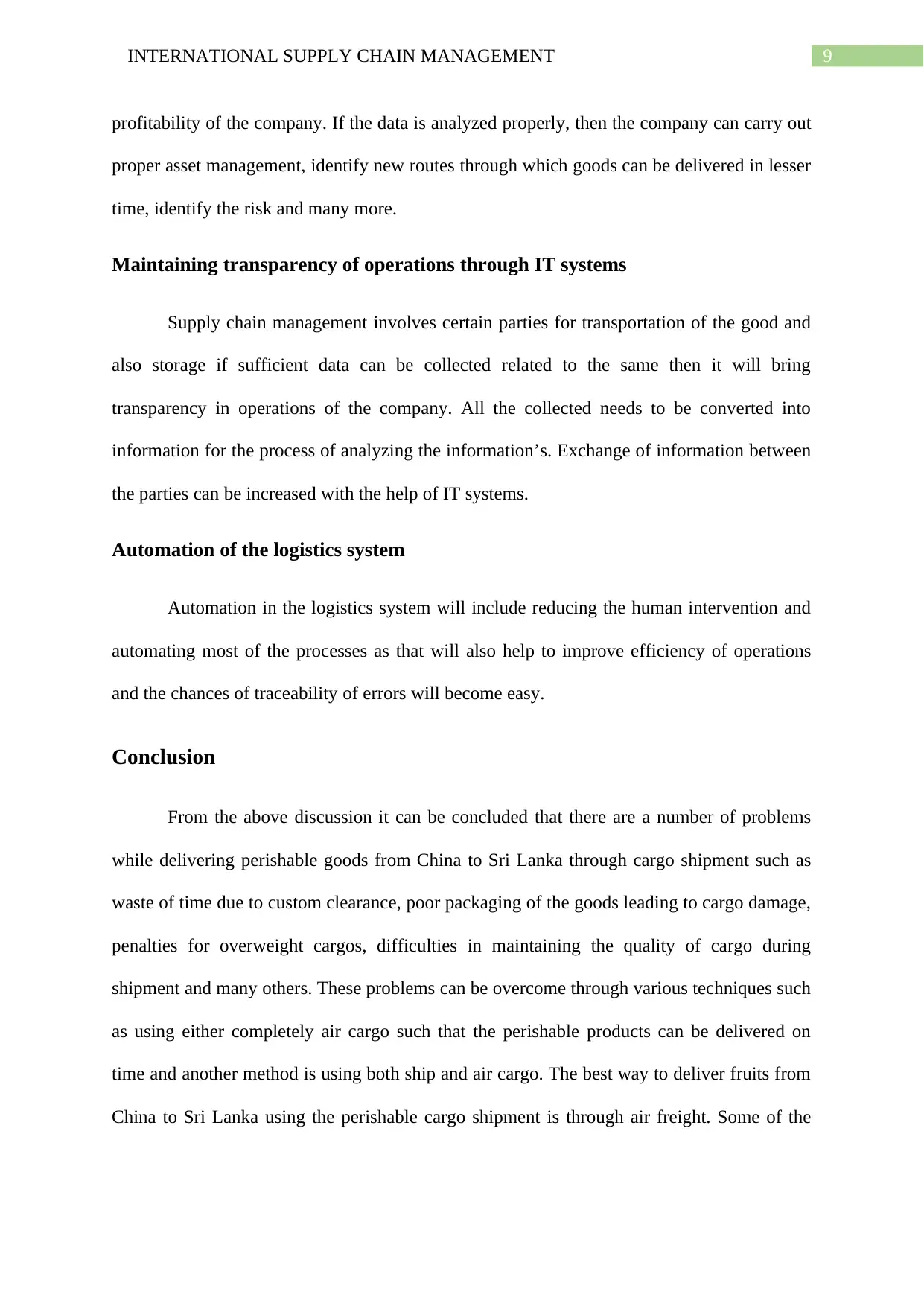
9INTERNATIONAL SUPPLY CHAIN MANAGEMENT
profitability of the company. If the data is analyzed properly, then the company can carry out
proper asset management, identify new routes through which goods can be delivered in lesser
time, identify the risk and many more.
Maintaining transparency of operations through IT systems
Supply chain management involves certain parties for transportation of the good and
also storage if sufficient data can be collected related to the same then it will bring
transparency in operations of the company. All the collected needs to be converted into
information for the process of analyzing the information’s. Exchange of information between
the parties can be increased with the help of IT systems.
Automation of the logistics system
Automation in the logistics system will include reducing the human intervention and
automating most of the processes as that will also help to improve efficiency of operations
and the chances of traceability of errors will become easy.
Conclusion
From the above discussion it can be concluded that there are a number of problems
while delivering perishable goods from China to Sri Lanka through cargo shipment such as
waste of time due to custom clearance, poor packaging of the goods leading to cargo damage,
penalties for overweight cargos, difficulties in maintaining the quality of cargo during
shipment and many others. These problems can be overcome through various techniques such
as using either completely air cargo such that the perishable products can be delivered on
time and another method is using both ship and air cargo. The best way to deliver fruits from
China to Sri Lanka using the perishable cargo shipment is through air freight. Some of the
profitability of the company. If the data is analyzed properly, then the company can carry out
proper asset management, identify new routes through which goods can be delivered in lesser
time, identify the risk and many more.
Maintaining transparency of operations through IT systems
Supply chain management involves certain parties for transportation of the good and
also storage if sufficient data can be collected related to the same then it will bring
transparency in operations of the company. All the collected needs to be converted into
information for the process of analyzing the information’s. Exchange of information between
the parties can be increased with the help of IT systems.
Automation of the logistics system
Automation in the logistics system will include reducing the human intervention and
automating most of the processes as that will also help to improve efficiency of operations
and the chances of traceability of errors will become easy.
Conclusion
From the above discussion it can be concluded that there are a number of problems
while delivering perishable goods from China to Sri Lanka through cargo shipment such as
waste of time due to custom clearance, poor packaging of the goods leading to cargo damage,
penalties for overweight cargos, difficulties in maintaining the quality of cargo during
shipment and many others. These problems can be overcome through various techniques such
as using either completely air cargo such that the perishable products can be delivered on
time and another method is using both ship and air cargo. The best way to deliver fruits from
China to Sri Lanka using the perishable cargo shipment is through air freight. Some of the
Paraphrase This Document
Need a fresh take? Get an instant paraphrase of this document with our AI Paraphraser

10INTERNATIONAL SUPPLY CHAIN MANAGEMENT
major techniques for overcoming the challenges is through automation of inventory
management, automation of logistics and many others.
major techniques for overcoming the challenges is through automation of inventory
management, automation of logistics and many others.
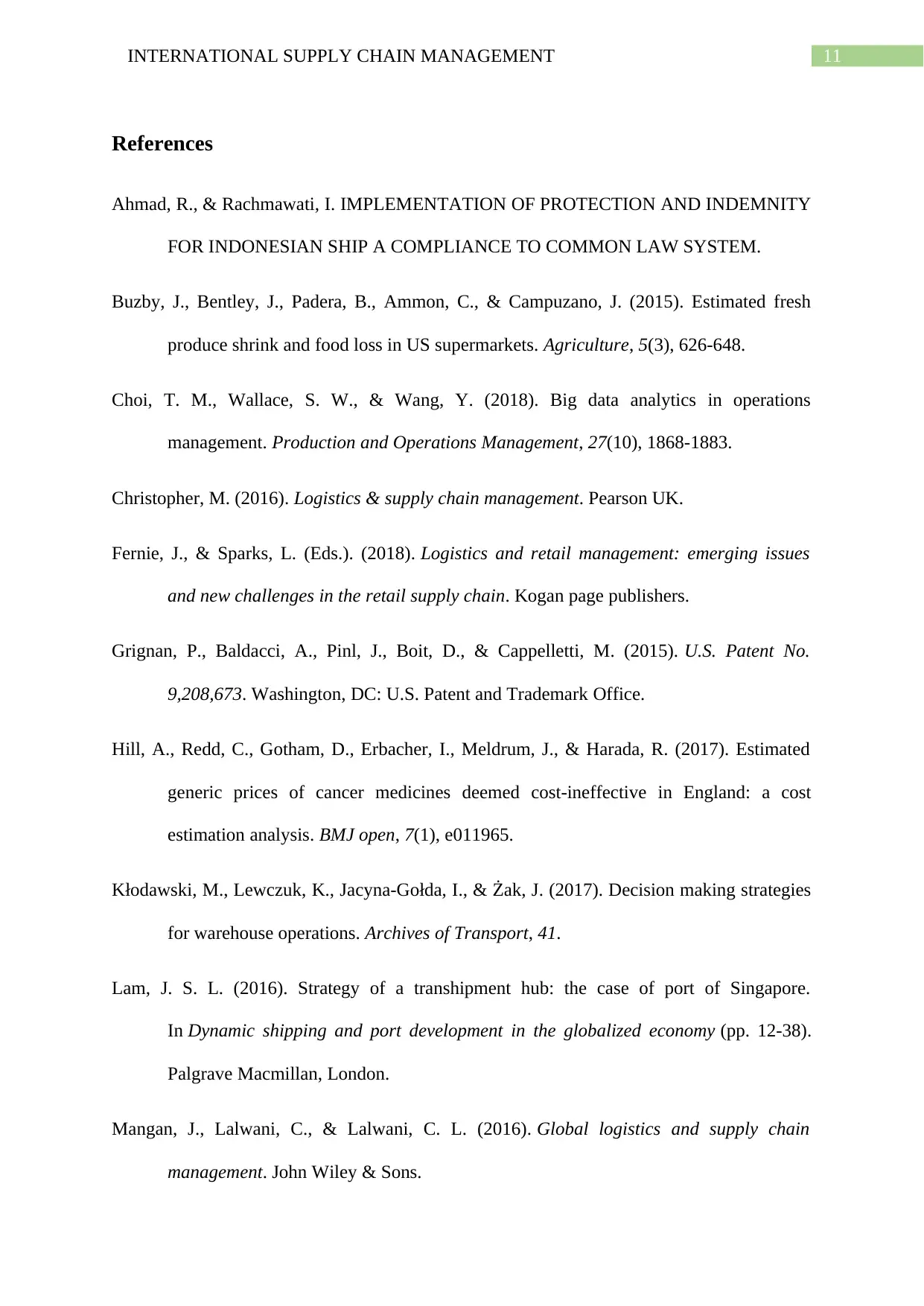
11INTERNATIONAL SUPPLY CHAIN MANAGEMENT
References
Ahmad, R., & Rachmawati, I. IMPLEMENTATION OF PROTECTION AND INDEMNITY
FOR INDONESIAN SHIP A COMPLIANCE TO COMMON LAW SYSTEM.
Buzby, J., Bentley, J., Padera, B., Ammon, C., & Campuzano, J. (2015). Estimated fresh
produce shrink and food loss in US supermarkets. Agriculture, 5(3), 626-648.
Choi, T. M., Wallace, S. W., & Wang, Y. (2018). Big data analytics in operations
management. Production and Operations Management, 27(10), 1868-1883.
Christopher, M. (2016). Logistics & supply chain management. Pearson UK.
Fernie, J., & Sparks, L. (Eds.). (2018). Logistics and retail management: emerging issues
and new challenges in the retail supply chain. Kogan page publishers.
Grignan, P., Baldacci, A., Pinl, J., Boit, D., & Cappelletti, M. (2015). U.S. Patent No.
9,208,673. Washington, DC: U.S. Patent and Trademark Office.
Hill, A., Redd, C., Gotham, D., Erbacher, I., Meldrum, J., & Harada, R. (2017). Estimated
generic prices of cancer medicines deemed cost-ineffective in England: a cost
estimation analysis. BMJ open, 7(1), e011965.
Kłodawski, M., Lewczuk, K., Jacyna-Gołda, I., & Żak, J. (2017). Decision making strategies
for warehouse operations. Archives of Transport, 41.
Lam, J. S. L. (2016). Strategy of a transhipment hub: the case of port of Singapore.
In Dynamic shipping and port development in the globalized economy (pp. 12-38).
Palgrave Macmillan, London.
Mangan, J., Lalwani, C., & Lalwani, C. L. (2016). Global logistics and supply chain
management. John Wiley & Sons.
References
Ahmad, R., & Rachmawati, I. IMPLEMENTATION OF PROTECTION AND INDEMNITY
FOR INDONESIAN SHIP A COMPLIANCE TO COMMON LAW SYSTEM.
Buzby, J., Bentley, J., Padera, B., Ammon, C., & Campuzano, J. (2015). Estimated fresh
produce shrink and food loss in US supermarkets. Agriculture, 5(3), 626-648.
Choi, T. M., Wallace, S. W., & Wang, Y. (2018). Big data analytics in operations
management. Production and Operations Management, 27(10), 1868-1883.
Christopher, M. (2016). Logistics & supply chain management. Pearson UK.
Fernie, J., & Sparks, L. (Eds.). (2018). Logistics and retail management: emerging issues
and new challenges in the retail supply chain. Kogan page publishers.
Grignan, P., Baldacci, A., Pinl, J., Boit, D., & Cappelletti, M. (2015). U.S. Patent No.
9,208,673. Washington, DC: U.S. Patent and Trademark Office.
Hill, A., Redd, C., Gotham, D., Erbacher, I., Meldrum, J., & Harada, R. (2017). Estimated
generic prices of cancer medicines deemed cost-ineffective in England: a cost
estimation analysis. BMJ open, 7(1), e011965.
Kłodawski, M., Lewczuk, K., Jacyna-Gołda, I., & Żak, J. (2017). Decision making strategies
for warehouse operations. Archives of Transport, 41.
Lam, J. S. L. (2016). Strategy of a transhipment hub: the case of port of Singapore.
In Dynamic shipping and port development in the globalized economy (pp. 12-38).
Palgrave Macmillan, London.
Mangan, J., Lalwani, C., & Lalwani, C. L. (2016). Global logistics and supply chain
management. John Wiley & Sons.
⊘ This is a preview!⊘
Do you want full access?
Subscribe today to unlock all pages.

Trusted by 1+ million students worldwide
1 out of 13
Related Documents
Your All-in-One AI-Powered Toolkit for Academic Success.
+13062052269
info@desklib.com
Available 24*7 on WhatsApp / Email
![[object Object]](/_next/static/media/star-bottom.7253800d.svg)
Unlock your academic potential
Copyright © 2020–2025 A2Z Services. All Rights Reserved. Developed and managed by ZUCOL.





